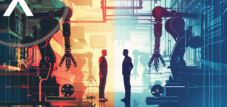🤖🌟 Collaboration of AI models: More than the sum of its parts
📈🤝 In many cases, it makes a lot of sense for multiple AI models to work together to cover different tasks within a company. This is often called an AI ecosystem or hybrid AI architecture, where different specialized models are integrated into one system to perform different functions.
Here are some reasons why and how different AI models can and often must work together:
📊 Specialization according to areas of responsibility
A single AI model is often specialized in processing a particular type of data or performing a specific task. For example:
- Language models (like GPT) excel at understanding and generating natural language. They are therefore well-suited for text-based applications such as customer service, automated reporting, or chatbots.
- Computer vision models, on the other hand, are specialized for processing image and video data and are frequently used in areas such as quality control, security, or visual inspections.
- Optimization and planning algorithms are used in logistics and production to, for example, make supply chains more efficient or improve inventory forecasts.
By combining these models, a company can implement a comprehensive solution that addresses diverse business needs.
Suitable for:
🔄 Data integration and decision-making
Many modern companies need to integrate diverse data sources to make complex decisions. For example, a machine learning model can perform predictive analytics by analyzing historical supply chain data. A separate language model could then translate these results into an understandable format and communicate the information to decision-makers or directly to customers.
Let's take the example of logistics:
- An AI-supported optimization model could calculate the best delivery route based on current traffic and weather data.
- At the same time, a computer vision system could take over the real-time monitoring of inventory and shipments.
- A language model can be used in a customer service chatbot to answer questions about delivery times or shipment tracking.
This collaboration of models automates a holistic process that ranges from planning and analysis to communication with customers.
💡 Interoperability and synergy effects
A major advantage of multiple AI models working together is interoperability, meaning the ability to communicate and exchange data. When different AI models function as modules of a larger system, they can combine their strengths. This creates synergies where the combination of models can achieve more than any single model could on its own.
One example would be combining a recommendation system with a language model. A recommendation algorithm analyzes customer data to make personalized product suggestions. These suggestions are then passed on to the customer by a language model, either via a website, an email, or even in a conversation with a virtual assistant. The language model understands the context and can even answer the customer's questions directly.
🖼️ AI for different types of data
Different business units often work with different types of data: structured data (such as databases), unstructured data (such as text documents), visual data (such as images), or audio data. A single AI model is typically unable to process all these different data types. Therefore, specialized models are needed for each data type, which then work together to provide a holistic view.
Example:
- In production, a computer vision model could be used for quality control to analyze images of products in order to detect defects.
- At the same time, a forecasting model based on historical production data could make predictions about demand or machine failures.
- Finally, a language model could explain the results of these analyses to the relevant employees in natural language or incorporate them into reports.
Suitable for:
🔄 Flexibility and adaptability
Using multiple AI models also makes a company more flexible and adaptable. Each model can be further developed, trained, or replaced separately without requiring changes to the entire system. This allows companies to implement AI gradually and add new capabilities as needed.
Imagine a company starts with a predictive model for demand forecasting and later adds a language model to automatically communicate these forecasts to its workforce. The combination of these models creates a dynamic and adaptable solution that can respond to future business needs.
Collaboration between AI models is crucial
In practice, it is usually insufficient to use just one AI model for all tasks within a company. Instead, several specialized models are often required, working together to support complex business processes. This collaboration enables companies to apply AI to various areas and thus achieve optimal results.
The future of AI in the business sector undoubtedly lies in the combination and networking of various models that function as integrated yet specialized building blocks. Companies that recognize and utilize this potential can optimize their processes, increase customer satisfaction, and secure a competitive advantage.
Suitable for:
📣 Similar topics
- 🤖 Collaboration of AI models for business tasks
- 🌐 Integration of specialized AI architectures
- 💼 Optimization through hybrid AI systems
- 🧠 Specialization: Language and Vision Models
- 📈 Data integration for better decisions
- 💡 Interoperability in modern AI ecosystems
- 📊 Synergy effects through AI combinations
- 📷 AI for various data types in the company
- 🔄 Flexible and adaptable AI models
- 🚀 Future of AI: Networking and Combination
#️⃣ Hashtags: #AIEcosystem #HybridAI #Specialization #DataIntegration #Interoperability
We are there for you - advice - planning - implementation - project management
☑️ SME support in strategy, consulting, planning and implementation
☑️ Creation or realignment of the digital strategy and digitalization
☑️ Expansion and optimization of international sales processes
☑️ Global & Digital B2B trading platforms
☑️ Pioneer Business Development
I would be happy to serve as your personal advisor.
You can contact me by filling out the contact form below or simply call me on +49 89 89 674 804 (Munich) .
I'm looking forward to our joint project.
Xpert.Digital - Konrad Wolfenstein
Xpert.Digital is a hub for industry with a focus on digitalization, mechanical engineering, logistics/intralogistics and photovoltaics.
With our 360° business development solution, we support well-known companies from new business to after sales.
Market intelligence, smarketing, marketing automation, content development, PR, mail campaigns, personalized social media and lead nurturing are part of our digital tools.
You can find out more at: www.xpert.digital - www.xpert.solar - www.xpert.plus


